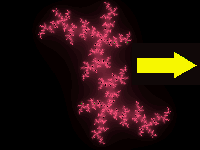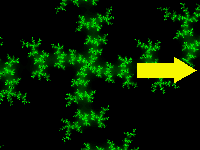General Fractal Information
Fractals are based on mathematical formulae. A slight change in the formula will produce a radically different fractal. This property will be demonstrated later.
Perhaps the most common of fractals are the Mandelbrot and the Julia. The Mandelbrot set is based on the formula z = z^2 + c where the initial value of z is 0 and c is a constant. To produce the Mandelbrot set, the value of z is iterated and c remains constant. The Julia set also utilizes the equation z = z^2 + c , but the value of c is fixed and the start value of z varies.
The background of this webpage is a Mandelbrot set.
Here is a Julia fractal:

One of the simplest of fractals is the Sierpinski Triangle. This graphic, acquired from the webpage of Wyvern Community School in the UK shows the construction of the Sierpinski Triangle.

This process iterates indefinitely, creating a form of infinite complexity. Infinite complexity is demonstrated by all fractals; however much you zoom in, there's always something new. The patterns seen when zooming in are often similar to the shape of the image as a whole, as demonstrated by this portion of the Julia set:

This attribute is even more profoundly demonstrated in this series of zooms into the Julia set






A slight change in the parameters of a fractal can cause significant changes. Here is a fractal based on the Newton formula for finding the roots of z^p - 1. The formula for this fractal is z(0) = pixel;
z(n+1) = ((p-1)*z(n)^p + 1)/(p*z(n)^(p - 1)).
The sole parameter in this formula is the polynomial degree P.
P=3

P=5

As you can see, in this type of fractal, the change in P changes the number of "spokes" in the "wheel" and affects the complexity of the spokes.
Want more information? Visit the links at My References and Further Reading Page
This page and all the graphics on it are created by Erin Piateski, unless otherwise noted.
Questions, comments? E-mail me at home or at school.










